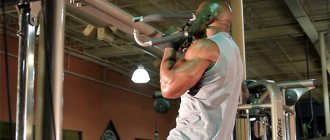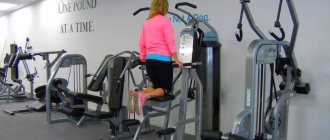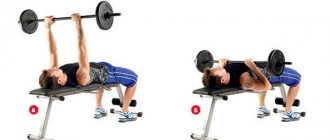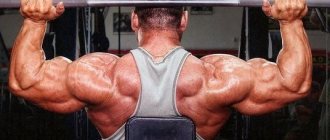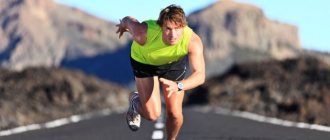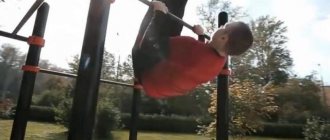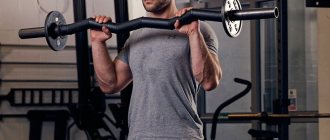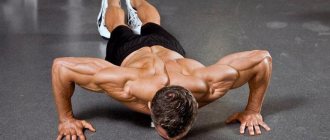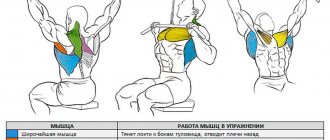- January 8, 2019
- Workouts in the gym
- Timoshenko Mikhail
Exercising on the horizontal bar is a great idea for placing increased stress on the muscles of the upper limbs and back. For these purposes, athletes quite often resort to reverse grip pull-ups. What muscles work when performing the exercise? What are the benefits of training? What types of pull-ups are there with a reverse grip? We'll talk about all this in our publication.
Advantages of the exercise
Before telling you which muscles work in reverse grip pull-ups and how the correct technique for performing the exercise is achieved, I would like to say a few words about the benefits of training. Exercises on the bar provide progressive strengthening of the back. There is a positive effect on the spine, in particular, stretching of local tissues and improved posture are observed.
By doing pull-ups with a reverse grip on the horizontal bar, you can achieve a visual increase in the volume of the upper limbs. The result of regular exercise is the growth of muscle mass on the back of the arms. The muscles in the presented zone become clearly defined and prominent.
Reverse grip pull-ups provide relief from tension after sitting in an uncomfortable position or performing heavy physical work. After a hard day, it’s enough to do a few approaches on the horizontal bar to feel instant relief. The main thing is to follow the correct technique for performing the exercise, which will avoid the risk of injury.
Pull-up variations and alternative exercises
1. Assisted pull-ups
Pull-ups can be quite challenging for beginners. To learn how to perform them in full amplitude, first you can use a special exercise machine, which is available in most gyms.
Here you can choose a weight that will be subtracted from your own body weight, meaning you will lift less weight than your body weight. This should make the exercise easier.
As you get stronger, you can reduce the assistance weight until you are attempting a full pull-up on your own.
2. Negative repetitions
This variation only involves the lowering phase, but it is still a great exercise for increasing strength.
You can stand on a bench or other support object so that your chin is above the horizontal bar. Take your feet off the bench and lower yourself down until your arms are fully extended and your feet touch the floor. Then stand back on the bench and repeat.
This exercise can help you build strength gradually. You will be more comfortable working with your own weight.
3. Weighted pull-ups
So, you have achieved perfection in performing pull-ups and want to complicate the exercise. This means you need to add weight.
The easiest way is to use a belt to hang additional weight. You can also simply hold a dumbbell between your legs. As you get stronger, you can gradually increase the weight.
Contraindications
Restrictions regarding performing pull-ups with a reverse grip apply primarily to people who suffer from pathologies of the musculoskeletal system. This exercise is absolutely not recommended for persons with the following diseases:
- Osteochondrosis, which occurs in acute form.
- Pathologies of the joints of the upper extremities.
- Presence of intervertebral hernias.
- Disc protrusion.
- Spinal curvatures: scoliosis, lordosis, kyphosis, spondylosis.
Reverse grip pull-ups - what muscles work?
Let's look at the muscle atlas involved during the exercise. What muscles work during reverse grip pull-ups? The main loads fall on the following units:
- Latissimus dorsi muscles.
- Posterior delta, radialis, trapezius, teres major, rhomboid, shoulder girdle muscles.
- The stabilizing muscles of the upper extremities are the biceps and triceps.
Pull-up program
If you have difficulty performing this exercise, and you can’t do more than 5-7 repetitions in one approach, try training with this program. It is designed for 10 workouts, the rest time between them should be 2-3 days. We do not only reverse grip pull-ups, but also other exercises for the back and arms in order to comprehensively work out all the muscles involved in the movement.
| Training no. | Exercises | Number of repetitions and approaches |
| 1 |
| 4x8 3x12 3x12 3x10 |
| 2 |
| 3x6 3x10 3x10 3x15 |
| 3 |
| 3x10 4x12 3 – to failure |
| 4 |
| 4x6 4x6 3 – to failure |
| 5 |
| 4x10 3x5 4x10 4x15 |
| 6 |
| 3x6 3x15 3 – to failure |
| 7 |
| 3x10 3x10 3x15 3x10 4x10 |
| 8 |
| 3x12 3x6 3x12 3 – to failure |
| 9 |
| 3x8 3x10 3x15 |
| 10 |
| 3x12 3x12 3x12 |
Recipes for healthy eating
Salad with beans, croutons and smoked sausage
- 5.6 g Protein
- 6 g Fat
- 16.5 g Carbohydrates
- 142.2 kcal
30 min.
- #second course
- #greenery
- #yogurt
- #sausage
- #carrot
- #dinner
- #snack
- #salad
- #salted cucumbers
- #spices
- #dinner
- #beans
Other recipes
Narrow grip
Pull-ups with a narrow reverse grip ensure that the main load is shifted to the arms. The back is involved here only in the initial phase of the amplitude of movement. Subsequently, the body body rises mainly due to flexion of the upper limbs at the elbow joints. According to biomechanics, the exercise is a kind of analogue of lifting a barbell. Maximum narrowing of the palm position makes it possible to work the biceps more isolated. However, such actions are fraught with harm to the condition of the wrist ligaments. If you feel severe discomfort in this position, it is advisable to separate your palms at a distance of at least 15 cm from each other.
Bottom line
Regardless of whether you decide to use a forward or reverse grip pull-up, stick to the correct technique, or better yet, alternate between both of these exercises. Only in this case will the load on the back muscles be distributed evenly. If you notice that one side of your back is not developing as quickly as the other, compensate for the load with pull-ups on one arm, or use unilateral rows to the dumbbell belt
Medium grip
Placing your hands shoulder-width apart helps you imitate a lat pull-down on a machine. What muscles are pumped during reverse grip pull-ups in this case? The outer zones of the latissimus dorsi muscles are worked out most efficiently. As a result of regular exercises, a V-shaped torso is formed. To achieve this result, it is extremely important to try to avoid increased range of motion of the arms. The main emphasis should be on tensioning the back, creating a pronounced arch in the chest area.
Wide grip: recommendations
Wide-grip pull-ups look like an extremely useful exercise for athletes who are looking to build impressively toned small back muscles. However, training according to the noted principle is not without its drawbacks. Wide palm placement “twists” the elbows inward. Being in a suspended position on the horizontal bar begins to cause considerable discomfort. Using special straps does not improve the situation. To avoid trouble, it is advisable to only slightly reach the bar with your chin, maintaining a small range of movements.
How to exercise on the horizontal bar
The effectiveness of exercises largely depends on the correctness of their implementation. Pull-ups are no exception. Let's look at the rules that apply to each type.
- pull-ups are performed using muscle strength, without inertia and body swaying
- lifting is carried out without jerking
- The chin at the top of the lift should be above the bar
- the descent is smooth, equal in time to the ascent
- correct breathing: exhale on the way up, inhale on the way down
- strong grip
- vertical position of the body
- The starting position for all types of pull-ups (except for pull-ups with a wide grip behind the head) is hanging, bending in the back, legs bent at the knees and crossed
About proper technique
Having decided on the appropriate grip width, proceed directly to the exercise. Pay attention to the way you grip the bar with your fingers. When performing pull-ups with a reverse grip, experienced athletes advise placing the index finger under the thumb. The solution makes it possible to concentrate loads on the forearms and biceps. However, this point is not fundamental. Grab the bar in a different way if the marked option causes inconvenience. At the same time, keep in mind that it is much easier to maintain a stable body position on the bar if you have a closed grip around the bar with your fingers.
While hanging on the horizontal bar, tighten your back muscles and perform an upward traction movement. The initial part of the amplitude must be overcome precisely due to the specified muscles. To better feel the contraction of the back tissues, squeeze your shoulder blades tightly together and bend in the thoracic spine. Perform the pull-up smoothly while exhaling. Be careful not to throw your head back, which is a common mistake for most beginners. The action is fraught with the creation of excessive compression on the spine in the cervical region. When moving your body in the direction of the bar, it is also important not to spread your elbows to the sides, moving them along the body.
Place your chin just above the level of the bar. Achieve maximum contraction of the abdominal muscles. Avoid body rocking. At the top point, perform a short delay for a few seconds. This action will allow you to once again concentrate the load on the latissimus dorsi muscles. As you inhale, slowly move your body down, spreading your shoulder blades. Avoid jerking and control every movement. At the final bottom point, try not to fully extend your arms. Just straighten your back. After a couple of seconds, do the exercise again. Having finished with the repetitions, come down from the horizontal bar, smoothly standing on your feet. It is not recommended to jump off the bar with a sudden movement.
How many times should you repeat the exercise using the above technique? The defining moment is the athlete’s training goals. If your main goal is to progressively increase the size of your triceps, do 8-12 pull-ups per set, doing 3-4 sets. To increase strength and endurance, train until your muscles completely fail.
General recommendations for performing pull-ups
Remember that following the correct technique will protect you from injury and increase the effectiveness of the exercise.
- When performing pull-ups with a direct grip, the main emphasis should be on the latissimus dorsi muscle.
- While on a sports apparatus, tense your abdominal muscles and do not allow your body to sway.
- During all phases of the exercise, ensure that your back remains straight.
- Tighten the muscles you want to develop.
- The pull-ups themselves are performed slowly and smoothly, without jerking or unnecessary movements.
- Once you have sufficiently mastered this type of pull-up, start using weights to increase the load.
- Please note that the distance between the hands varies depending on the type of grip.
- If pull-ups with a narrow arm position are difficult for you, use special harnesses to reduce the load.
Remember that not everyone can do pull-ups. Pull-ups with a narrow arm placement are contraindicated in the following cases:
- If you have scoliosis, kyphosis, lordosis or osteochondrosis.
- Intervertebral hernias and other spinal problems.
- Excess weight. Pull-ups are good for training muscles, but are not suitable for those who want to lose weight.
- Insufficient physical training.
- Hand injuries or serious joint problems.
If you have long wanted to pump up beautiful biceps and strengthen your back, but you don’t dare to do it because you don’t have time to go to the gym or it’s expensive, then a horizontal bar is exactly what you need. Its accessibility and simplicity should not be misleading; it is an excellent sports equipment for developing the muscles of the arms and back. But remember that the best effect is achieved only with constant training and using a whole range of exercises.
Useful tips
To ensure that reverse grip pull-ups allow you to achieve the best possible results, pay attention to the following points:
- Keep your core muscles tense. The action will ensure that the body is maintained in a stable position, avoiding swaying on the horizontal bar. For the same reason, do not allow auxiliary swings of the lower limbs.
- It is more advisable to do several slow, smooth repetitions of the exercise, observing the correct technique, rather than perform a whole series of jerks. Sudden movements not only cause a decrease in the quality of muscle pumping, but also significantly increase the risk of accidental injury.
- When performing a dozen pull-ups with a reverse grip using the correct technique is no longer difficult, move on to weight training. Securing the load on an athletic belt will allow you not to stop at the progress achieved.

